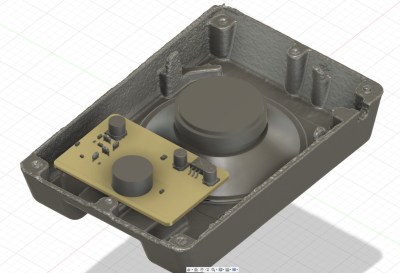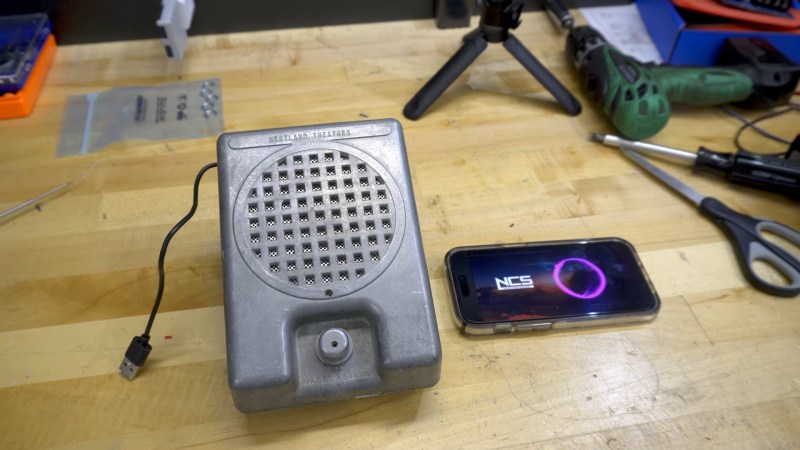Readers of a certain vintage no doubt have pleasant memories of drive-in theaters, and we are chuffed to see that a few hundred of these cinematic institutions endure today. While most theaters broadcast the audio on an FM station these days, the choice is still yours to use the chunky, often crackly speaker that attaches to the car window.
 Seeking to relive the drive-in audio experience at home, [codemakesitgo] picked up a drive-in theater speaker on eBay and turned it into a Bluetooth device that sounds much better than it did in its weather-beaten days outside.
Seeking to relive the drive-in audio experience at home, [codemakesitgo] picked up a drive-in theater speaker on eBay and turned it into a Bluetooth device that sounds much better than it did in its weather-beaten days outside.
There isn’t a whole lot to this build — it’s essentially a new speaker cone, a Bluetooth receiver, an amp, and a battery. The real story is in the way that [codemakesitgo] uses Fusion360 to bring it all together.
After 3D scanning the case, [codemakesitgo] made sure each piece would fit, using a custom-built model of the new speaker and a 3D model of a custom PCB. Good thing, too, because there is barely enough clearance for the speaker. Be sure to check out the brief demo video after the break.
















There are many free text-to-speech converters that produce a much better quality voice than this Chinese woman that tries to speak English. It ruins the total experience.
You should demand a refund or, you know, stop imposing your personal standards of speech on other people, like any other decent human being. Your choice.
“stop imposing your personal standards of speech on other people”
It’s not a person. It’s electronics. And I’m not “imposing” anything. Ironically, you are the one who is more imposing by trying to shame me, by implying I’m not a decent human being for merely having standards on products. And my comment was constructive feedback as I gave a solution (using a better text-to-speech converter), whereas your comment is just purely emotional.
Based
That voice is probably not made with Text-to-speech. That is a real, spoken audio sample that these Bluetooth-receivers have in their firmware.
For a moment I was surprised by the use of the word “Drive-In”.
I thought that car crazy nations like the states do rather say “Drive-Thru”.
“Drive-In” is something I hear here in modern day Germany, but it really means “Drive-Thru”.
But apparently, real “Drive-In”s seem to have existed, too.
They are a thing of the distant past, though (in the US).
According to what I find online, long upon a time they had “restaurants” there were people could drive in with their beloved cars. They had service personell who brought them food etc.
Source:
https://www.auswandern.us/drive.html
Drive-in restaurants still exists. Sonic is probably the best known drive-in places currently although some old A&W restaurant still has drive-in option. Drive-in movie theaters are still around but it’s rare because they are at the mercy of weather and can only run at night so one showing per screen per night.
Not one showing per screen per night. I’ve been to a double-feature at a drive-in. As a timestamp, one of the movies was Firefox and I can’t remember the other one. That would put it in 1982.
“one showing per screen per night”
Mainly depends upon the theater. Some have multiple screens to show multiple films at the same time on screens facing different directions and some stay open very late and show multiple films. COVID caused a resurgence of drive-in theaters for obvious reasons as have the same nostalgic forces made evident in the growing retro-computer scene.
Lots of free-view documentaries about them here:
https://tubitv.com/search/drive-in
One showing? I don’t think so.
Double features were pretty much the staple of Drive-ins. Granted, that did make for a late night most of the year.
The incredibly bright screens like those in modern sporting arenas would be enough to allow daytime viewing, but be too expensive I suppose.
Every drive-in I’ve been to shows double features, basically two movies back to back for the price of one. Many drive-ins also have multiple screens, the one in Reo, Indiana has 6 or 7 actually.
Ah yes, we should stop being so car crazy and just bike 15 miles to work, or only live and work in places where there’s trains or buses going everywhere at all hours, even though that’s way more expensive and less pleasant than simply living further away and using a car. And even then, if your family lives in one place but the only workplace available for someone with your skills is 75 miles away… you need to drive.
I’m really curious what’s the “etc” that the “service personnel” are supposed to be providing – they sure never did me any etc! They just walk over and bring the food and leave. Oh well, at least it’s a quick meal with relative privacy and safety. Not really much different from the drive-thru’s where you’re asked to pull to the other lane once you’ve made your purchase and are awaiting your food, except that you don’t have to go anywhere until you’re ready.
Drive-in theaters definitely still exist. You can find a decent listing at https://www.driveinmovie.com/united-states
I’ve never been to one that still used the speakers attached to the poles. They just broadcast the audio for each screen on a seperate short range FM signal. I went to a small, single screen drive-in over the summer that did an interesting variation – they loaned out small, nostalgia styled FM radios at the concession area. You just needed to leave your driver’s license and pick it up upon return.
Two things that really killed drive-in theaters were the digitization of film distribution and urban sprawl. Most, if not all, drive-in were/are family owned and most could not afford to switch to digital projectors. I remember reading about one local drive-in doing a fundraiser trying to come up with the $50-60k necessary. Some also entered raffles to win projectors in studion promotions. Drive-in’s were traditionally established on cheap land away from the light pollution of town centers but as cities expanded and the suburbs swelled many theaters became situated on parcels of land they could no longer afford or were made offers they couldn’t refuse so the land could be paved over and repurposed.
I don’t think I said they didn’t exist? They’re rare though.
There’s a small local theater, not a drive-in, which only gets films later on presumably for a lower price. For a drive-in, I imagine it might be a little harder to get a bright enough digital projector no matter the time of day, but the sort that goes in a lecture hall might be more affordable if you’re able to use those with whatever format you need to use when you’re buying the rights to sell tickets to a film instead of for personal use. I’m also not familiar with the price structure they use fo So there’s ways to cut costs a little.
I did have an idea for what an ideal future drive-in could be like. It’d have to find things that it could do to make money other than trying desperately to increase ticket sales. What if it had a row of EV charging spots? Not super-fast chargers, just decent speed. Provide wifi, snacks, and a restroom, and both your moviegoers and your EV drivers will appreciate it. Maybe you could have other videos – not pricey films, but something that’s not available for free – available either onscreen or over wifi when not showing normal stuff. Maybe a small number of cars per projector (cheaper projectors, daytime may even be possible in the shade) could let you let small groups choose what to watch. That’s all a bit questionable, of course. The main thing was the charging and resources. I guess a similar alternative is to be an RV park that also happens to show movies.
Drive-in and drive-thru are different things.
A drive-in is where you stay in, a drive-thru is where you just collect.
McDonalds has a drive-thru, a movie theater (where you stay to watch a movie in your car) is a drive-in. If it was a drive-thru movie theater, it would have to be a very short movie.
A drive-thru theatre would be something showing 5 minute videos from bang bros 😂
Drive-in theaters also use a lot of land, and if they are convenient enough to attract an audience the land value eventually becomes high enough to make it too tempting to turn them into condominiums. This was the fate of all the drive-ins in the New Orleans metro area even though they were very popular through the 1970’s.
Yah, the beloved one near my hometown got sold not because it wasn’t profitable, it apparently was doing gangbusters for the people who owned it, but because someone offered them a huge chunk of cash they couldn’t refuse. Making them in essence the 80s movie villains who won. No teenage hijinks could save the drive-in.
The funny part is, after the dev bought the land, tore down the drive-in, and built stuff on it everything tanked and the last time I was in the area, most everything was either empty or getting flattened because the buildings were abandoned and falling down from neglect.
I could fill a 500 car drive in with 25 Road Runner cartoons.
People would put the speaker on top of the post and they would fill with water.
Next morning cleaner would dump the water and by evening they were good as new (almost)
Drive-in theaters definitely still exist. You can find a decent listing at https://www.driveinmovie.com/united-states
I’ve never been to one that still used the speakers attached to the poles. They just broadcast the audio for each screen on a seperate short range FM signal. I went to a small, single screen drive-in over the summer that did an interesting variation – they loaned out small, nostalgia styled FM radios at the concession area. You just needed to leave your driver’s license and pick it up upon return.
Two things that really killed drive-in theaters were the digitization of film distribution and urban sprawl. Most, if not all, drive-in were/are family owned and most could not afford to switch to digital projectors. I remember reading about one local drive-in doing a fundraiser trying to come up with the $50-60k necessary. Some also entered raffles to win projectors in studion promotions. Drive-in’s were traditionally established on cheap land away from the light pollution of town centers but as cities expanded and the suburbs swelled many theaters became situated on parcels of land they could no longer afford or were made offers they couldn’t refuse so the land could be paved over and repurposed.
Here in Canada, in addition to the speaker, there was a second box on the post: a heater. That was the only time we were really warm in my VW Beetle.